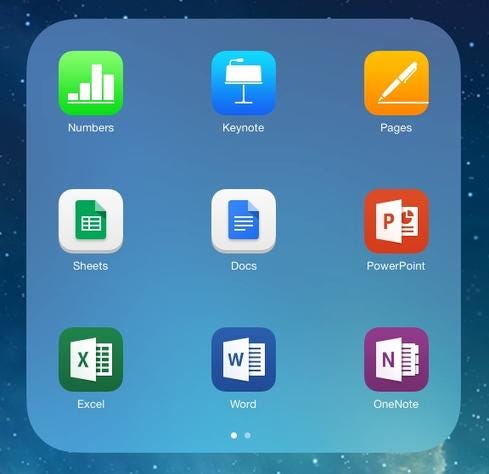Windows XP Stayin' AliveWindows XP Stayin' Alive
Microsoft no longer supports Windows XP, but 25% of PC users still use it today -- twice as many as use Windows 8 and 8.1.


Microsoft Office For iPad Vs. iWork Vs. Google
Microsoft Office For iPad Vs. iWork Vs. Google (Click image for larger view and slideshow.)
You've got to hand it to people who still use Windows XP -- they're a resolute bunch. Microsoft stopped supporting the enormously popular OS almost three months ago, but according to the newest figures from Web tracking firm Net Applications, more than a quarter of PC users still relied on XP in June.
XP remains resilient despite Microsoft's multi-year upgrade campaign, which included frequent reminders that the OS would become vulnerable to malware, and even a zero-day scare shortly after Microsoft ceased support. The latter pressured the company to issue a security fix in a "one-time exception" to its support policy.
[How are Surface Pro 3 early adopters using Microsoft's new tablet? Read Microsoft Surface Pro 3: Customers Speak.]
Net Applications, which scans a network of 40,000 websites and 160 million unique users each month, found that Windows 7 remained the top OS overall, with 50.55% of PC users. That was up meaningfully from 50.06% in May and 49.27% in April. Retailers and OEMs have deemphasized Windows 7 in their consumer offerings, but Net Application's new numbers reinforce that among businesses that recently upgraded from XP, most chose Windows 7.
Windows XP remained the second most popular OS by a large margin. It snared 25.31% of users in June -- basically flat compared to May. XP commanded 37.17% of the market in June 2013 and more than 29% in January, which means that millions of XP users have indeed upgraded to newer platforms.
But millions still remain, and XP's rate of attrition is slowing. Some businesses are paying Microsoft for extended XP support, and many third-party security vendors offer XP-oriented products and services as well. Consequently, not all of the XP traffic, which is drawn from users who connect to the public Internet, necessarily represents the same security risk.
Windows 8 and 8.1's flat-lining growth speaks to why Microsoft's older OSes remain so popular: Existing Windows customers simply haven't felt compelled to upgrade. In June, Windows 8.1 accounted for 6.61% of the market, up a bit from 6.35% in May. The original version of Windows 8 held 5.93%, down from 6.29% the month before.
With almost 53% of the combined Win 8/8.1 user base, Windows 8.1 achieved its greatest share to date. That said, it remains somewhat puzzling that more Win 8 users haven't moved to 8.1, given that the update is free and earned better reviews than its maligned predecessor. Moreover, Win 8/8.1 combined for only 12.54% of users, which was not only less than half Windows XP's share, but also down from May's 12.64%.
Apple's top performer was Mac OS X 10.9 (Mavericks), which is the current version. It grabbed 3.95% of users. That accounted for almost three-fifths of the overall Mac user base. Fewer than 14% of Windows customers, in contrast, have moved to Windows 8 or 8.1. Apple CEO Tim Cook made a similar comparison last month, arguing that Mac customers find OS X more appealing than Windows customers find Windows 8 or 8.1. That might be true, but Net Application's numbers still point to concerns for Apple.
Macs accounted for only 6.73% of PC users overall -- Apple's worst share so far this year. There's a certain amount of noise implicit in Net Applications' sampling methodology, but Apple's computers appear to have lost steam in recent months. OS X's June share was down precipitously from 7.39% in May, and 7.62% in April. The company recently introduced low-cost iMac and MacBook Air models, but Apple this year has otherwise left its consumer PC lineup relatively unchanged. Some would-be customers might have grown impatient and moved on, and some might be waiting for product refreshes.
Windows accounted for 91.53% of the market in June, up from 90.99% in May. Still, Microsoft is surely concerned by Windows 8 and 8.1's stalled growth. Newer, flashier devices could help, including the Surface Pro 3 as well as the fleet of svelte, powerful Ultrabooks recently introduced at the Computex trade show. But Microsoft is moving toward a cloud-focused future, while most of its Windows customers stick with OSes rooted in the past. Based on the most recent rumors, the company will attempt to reenergize the user base with Windows 9. It will allegedly run differently on different types of devices, and will include a desktop-oriented version in which the tiled Start screen is disabled by default.
information's new Must Reads is a compendium of our best recent coverage of the Internet of Things. Find out the way in which an aging workforce will drive progress on the Internet of Things, why the IoT isn't as scary as some folks seem to think, how connected machines will change the supply chain, and more. (Free registration required.)
About the Author
You May Also Like






